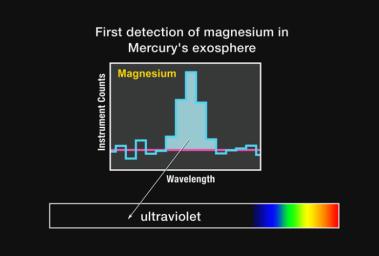
|
First Detection of Magnesium in Mercury’s Exosphere
- Click the image above for a larger view
- Full-Res JPEG (720 x 486) (26.4 kB)
- Full-Res TIFF (720 x 486) (1.1 MB)
Caption:
The histogram in this figure represents a typical MASCS observation in the tail region of Mercury's exosphere from magnesium atoms. These MASCS measurements mark the first time that magnesium has been detected in Mercury's exosphere. In contrast to emissions from sodium and calcium (see PIA11402 ), magnesium emission occurs at a wavelength that is in the ultraviolet part of the spectrum. Magnesium has not been observed from ground-based telescopes partly because it emits at ultraviolet wavelengths, which are completely obscured by Earth's atmosphere. Because these atoms primarily originate at the surface of Mercury, the detection of magnesium in the exosphere provides evidence that magnesium is a component of surface material, something that has been expected for years but until now had not been proven. As with calcium and sodium, the distribution of magnesium in Mercury's exosphere is a result of the processes that release the magnesium atoms from the surface and can provide valuable clues to the relative importance of each process.
Date Acquired:
October 6, 2008
Instrument:
Mercury Atmospheric and Surface Composition Spectrometer (MASCS)
Background Info:
These images are from MESSENGER, a NASA Discovery mission to conduct the first orbital study of the innermost planet, Mercury. For information regarding the use of images, see the MESSENGER image use policy .
Cataloging Keywords:
| Name | Value | Additional Values |
|---|---|---|
| Target | Mercury | |
| System | ||
| Target Type | Planet | |
| Mission | MESSENGER | |
| Instrument Host | MESSENGER | |
| Host Type | Orbiter | |
| Instrument | Mercury Atmospheric and Surface Composition Spectrometer (MASCS) | |
| Detector | ||
| Extra Keywords | Atmosphere, Color, Ultraviolet | |
| Acquisition Date | ||
| Release Date | 2008-10-30 | |
| Date in Caption | 2008-10-06 | |
| Image Credit | NASA/Johns Hopkins University Applied Physics Laboratory/Carnegie Institution of Washington | |
| Source | photojournal.jpl.nasa.gov/catalog/PIA11409 | |
| Identifier | PIA11409 | |
